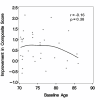Designing clinical trials for assessing the effects of cognitive training and physical activity interventions on cognitive outcomes: the Seniors Health and Activity Research Program Pilot (SHARP-P) study, a randomized controlled trial
- PMID: 21615936
- PMCID: PMC3126708
- DOI: 10.1186/1471-2318-11-27
Designing clinical trials for assessing the effects of cognitive training and physical activity interventions on cognitive outcomes: the Seniors Health and Activity Research Program Pilot (SHARP-P) study, a randomized controlled trial
Abstract
Background: The efficacy of non-pharmacological intervention approaches such as physical activity, strength, and cognitive training for improving brain health has not been established. Before definitive trials are mounted, important design questions on participation/adherence, training and interventions effects must be answered to more fully inform a full-scale trial.
Methods: SHARP-P was a single-blinded randomized controlled pilot trial of a 4-month physical activity training intervention (PA) and/or cognitive training intervention (CT) in a 2 × 2 factorial design with a health education control condition in 73 community-dwelling persons, aged 70-85 years, who were at risk for cognitive decline but did not have mild cognitive impairment.
Results: Intervention attendance rates were higher in the CT and PACT groups: CT: 96%, PA: 76%, PACT: 90% (p=0.004), the interventions produced marked changes in cognitive and physical performance measures (p≤0.05), and retention rates exceeded 90%. There were no statistically significant differences in 4-month changes in composite scores of cognitive, executive, and episodic memory function among arms. Four-month improvements in the composite measure increased with age among participants assigned to physical activity training but decreased with age for other participants (intervention*age interaction p=0.01). Depending on the choice of outcome, two-armed full-scale trials may require fewer than 1,000 participants (continuous outcome) or 2,000 participants (categorical outcome).
Conclusions: Good levels of participation, adherence, and retention appear to be achievable for participants through age 85 years. Care should be taken to ensure that an attention control condition does not attenuate intervention effects. Depending on the choice of outcome measures, the necessary sample sizes to conduct four-year trials appear to be feasible.
Trial registration: Clinicaltrials.gov Identifier: NCT00688155.
© 2011 Legault et al; licensee BioMed Central Ltd.
Figures




References
-
- Middleton LE, Yaffe K. Targets for prevention of dementia. J Alzheimers Dis. 2010;20:915–924. - PubMed
-
- Plassman BL, Williams JW, Burke JR, Holsinger T, Benjamin S. Systematic review: factors associated with risk for and possible prevention of cognitive decline in later life. Ann Intern Med. 2010;153(3):182–193. - PubMed
Publication types
MeSH terms
Associated data
Grants and funding
LinkOut - more resources
Full Text Sources
Medical
Miscellaneous

